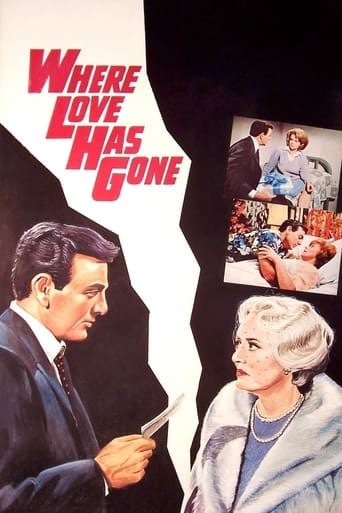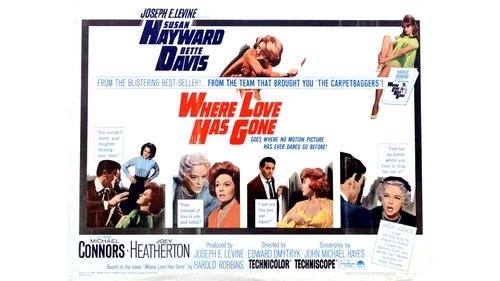MartinHafer
"Where Love Has Gone" is a bad movie. The characters are pretty much one-dimensional, the acting is about as subtle as a baseball at upside your head and the script is salacious and sleazy...yet, this film is incredibly entertaining because it's so over-the-top! Subtle, this movie ain't!! The film begins with a killing that I am sure was modeled after the true-life killing of Lana Turner's husband by her daughter from a previous marriage. Though the details aren't 100% certain, it sure bears a lot of similarity to the start of this film. It was a HUGE and very sensational story back in the 50s--and now the tale is being brought to the screen--in a story that has many, many changes from the original true tale.The next portion of the film is a long flashback. Susan Hayward lives with her very rich and extremely controlling and manipulative mother (Bette Davis). She's very unhappy yet she doesn't leave...though she longs for change. When a guy comes into her life (Chuck Connors), Hayward is smitten. Why? Because when Davis tries to wrap him around her finger, he tells her to take her money and stuff it! However, he has no idea that this is what made Hayward love him.Shortly after they marry, Connors' self-esteem is in the toilet. Behind his back, she made sure he'd fail in business and would be forced to work for her company. As a result of this, Connors is disheartened and starts to hit the bottle. And, because he's no longer the virile man who stood up to Davis, Hayward has contempt for him and his weakness--and their marriage fizzles. Soon, he's drunk all the time and she's whoring about with one boy-toy after another. Not surprisingly, they divorce--and the rest is history. These jerks apparently created the poor girl killer (Joey Heatherton) and the rest of the film is about the family trying to pick up the pieces. Who is best to raise this teen killer--the highly unstable and oversexed mother, the ex-alcoholic or the evil controlling mother? How it all ends is,....well....incredible! The plot idea isn't terrible. The problem is that the writing NEVER approaches subtlety or grace-and the ending is just WAAAY over the top!! It's full of screaming, sleaze and, well, a few more doses of sleaze! It's also hilariously preachy. The PRETENDS to be a morality tale to teach parents not to neglect their poor kids, but it's a very, very thin sort of veil for a bucket of steaming..., um,...soap. But it's also very entertaining and you can't keep your eyes off it--like a funny train wreck (if there could be such a thing). And, a lot like "Peyton Place".By the way, if you care, DeForrest Kelley is also in the film in a supporting role. And, oddly, he comes off the best of any of them--playing the role like he's NOT a combination of constipated and intensely mad!
williwaw
Paramount Pictures assigned star Producer Joseph E Levine to bring the torrid best seller roman a clef of the Lana Turner Johnny Stompanato murder to the screen. Levine cast surefire box office queen Susan Hayward to play "Lana, and to play the other strong female role, the one and only Ms. Bette Davis. There was a long time interest to see these two great stars in a film. Directed by Edward Dymtryk the film is a powerhouse with great acting by Susan Hayward and Bette Davis. I wish they had cast another actor other than Mike Connors in the role of Hayward's lover and Ann Margret rather than Joey Heatheron. Ms. Hayward got top billing over Ms. Davis--the first time in her great career Bette Davis was billed under another great female star!-- and wore great stylish outfits by Edith Head. It is now well known that Bette Davis and Susan Hayward did not get along at all during filming. Susan Hayward was afraid of Bette's well known use of tricks and since Susan Hayward had both cast approval and script approval and top billing, had Bette Davis boxed in. No changes were allowed. In fairness, the script did need more juice and a tougher script would have benefited the talents of Susan Hayward nd Bette Davis. Bette Davis carped about Susan Hayward until her death, and Susan Hayward joined Joan Crawford, Miriam Hopkins on Bette's "hate list". (Soon to be joined by Faye Dunaway and Lillian Gish. Where Love Has Gone with top notch Paramount production values is an old fashioned film and is best seen to see two great movie stars Susan Hayward and Bette Davis!
moonspinner55
Society sculptress in San Francisco marries a war veteran, a man who quickly turns to the bottle after failing to carve out his own niche away from the realm of his domineering mother-in-law; sometime later, the daughter they share apparently kills mom's lover in a jealous rage. Harold Robbins' best-selling roman à clef lifts its subplot from the real-life Lana Turner-Johnny Stompanato case, and those bits and pieces are rather interesting. However, much of the movie is spent with bickering marrieds Susan Hayward and inert Michael Connors trading barbs, and the promising idea loses its impetus and becomes a stillborn soaper. Connors, heavily made-up and with lacquered black hair that never changes during the story's many years, twitches and twists his mouth into a grimace throughout the entire picture, only coming to life while tipsy in a brief dinner scene. Hayward fares better, but her slurpy, silly lines are pure camp ("You're a kept-man, not a war hero! And a drunk! A drunk! A DRUNK!"). Bette Davis is pretty much wasted as Hayward's mother (who would've thought a film co-starring these two high-powered ladies could be so dull?) and Joey Heatherton scowls continuously as the teenager in trouble (I loved her retort though about how she lost her virginity: "It happened horseback riding!"). Tatty-looking picture has some fun trappings (such as Susan's round bed, Princess telephones, and fashions that often match the room decor), but the plot is lazy and Edward Dmytryk's direction is completely rote. Film opens with picture-postcard shots of San Francisco coupled with a cheesy title tune crooned by Jack Jones, which unbelievably netted an Oscar nomination! *1/2 from ****
Putzberger
The above phrase is how DeForrest Kelley (yep,"Bones") describes Susan Hayward's character in this film. You'll notice he doesn't use the term "beauty" or "enchantress." Those of us who have always been mystified by Susan Hayward's stardom will find no answers here, where she (over)plays a nymphomaniac sculptor whose daughter sticks a carving knife into her scumbag boyfriend. Since it's obviously based on the Lana Turner imbroglio of the late 50's, the filmmakers must have thought it appropriate to cast one lousy actress as another (but at least Lana was pretty). As a movie, it's awful. As a time capsule, it's priceless -- your jaw will drop so far you'll be inhaling dustbunnies when you get a load of the pre-Freudian view of female sexuality implied by this film.Exhibit 1: Susan's butch, blowzy nymphomaniac has intertwined drives to create and to procreate. Nothing too strange there ("eros" means to create, after all). But the film judges her harshly, punishing the woman for her free spirit much the way that Flaubert did Emma Bovary a century earlier (but at least Flaubert was a great artist). Don't tempt fate, girls -- leave the Pandora's box of female sexuality and female creativity alone! We're lucky Robbins, Dmytryk & co didn't get around to taking potshots at great, independent female artists like Isadora Duncan or Frida Kahlo, but then again, maybe their concept of "art" was limited to the Hollywood dreck that Lana Turner churned out. So we can thank our stars.Exhibit 2: Valerie, as played by Susan Hayward, was messed up by her domineering mother, portrayed by Bette Davis. This third-rate psychology was trite by the early 60s, a staple of horror films (see "Psycho"). Then again, maybe the subtext of the film is that Valerie represents a gay man . . . which might also explain casting Susan Hayward in the role.Exhibit 3 (most damning): Valerie's daughter Danielle, or "Danny" (there's a weird streak of androgyny running through this flick), played by Joey Heatherton, is fifteen years old, and no one . . . repeat, no one, not even her father . . . is horrified or even shocked to learn that she is no longer a virgin. The words "sexual abuse" and "statutory rape" are never used, not even by the psychologist who is treating the little murderess. Instead, dear old "Daddy," as played by Mike Connors, knits those massive eyebrows together (did he wash his face with Rogaine?) and wonders when she might have "made love." This kind of 19th-century attitude toward adolescent sexuality was dated by the time Nabokov wrote "Lolita," let alone the 1960s (even a sleazebag like Dean Martin didn't lay hands on Joey Heatherton, she was so young back then).So "Where Love Has Gone" is a movie more to be puzzled over and analyzed than enjoyed. Cultural Studies professors, get to work.




